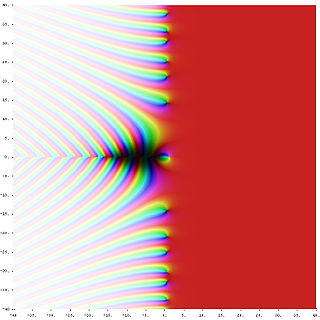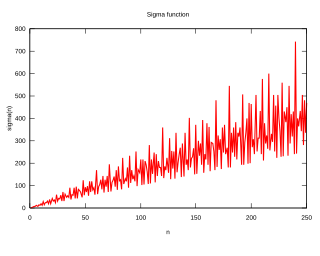
The Riemann zeta function or Euler–Riemann zeta function, denoted by the Greek letter ζ (zeta), is a mathematical function of a complex variable defined as

Goldbach's conjecture is one of the oldest and best-known unsolved problems in number theory and all of mathematics. It states that every even natural number greater than 2 is the sum of two prime numbers.

In mathematics, the floor function (or greatest integer function) is the function that takes as input a real number x, and gives as output the greatest integer less than or equal to x, denoted ⌊x⌋ or floor(x). Similarly, the ceiling function maps x to the smallest integer greater than or equal to x, denoted ⌈x⌉ or ceil(x).

In number theory, Goldbach's weak conjecture, also known as the odd Goldbach conjecture, the ternary Goldbach problem, or the 3-primes problem, states that

In mathematics, analytic number theory is a branch of number theory that uses methods from mathematical analysis to solve problems about the integers. It is often said to have begun with Peter Gustav Lejeune Dirichlet's 1837 introduction of Dirichlet L-functions to give the first proof of Dirichlet's theorem on arithmetic progressions. It is well known for its results on prime numbers and additive number theory.
In number theory, a formula for primes is a formula generating the prime numbers, exactly and without exception. Formulas for calculating primes do exist, however, they are computationally very slow. A number of constraints are known, showing what such a "formula" can and cannot be.
In mathematics, the Hardy–Ramanujan–Littlewood circle method is a technique of analytic number theory. It is named for G. H. Hardy, S. Ramanujan, and J. E. Littlewood, who developed it in a series of papers on Waring's problem.

In number theory, a colossally abundant number is a natural number that, in a particular, rigorous sense, has many divisors. Particularly, it is defined by a ratio between the sum of an integer's divisors and that integer raised to a power higher than one. For any such exponent, whichever integer has the highest ratio is a colossally abundant number. It is a stronger restriction than that of a superabundant number, but not strictly stronger than that of an abundant number.
In mathematics, a Kloosterman sum is a particular kind of exponential sum. They are named for the Dutch mathematician Hendrik Kloosterman, who introduced them in 1926 when he adapted the Hardy–Littlewood circle method to tackle a problem involving positive definite diagonal quadratic forms in four as opposed to five or more variables, which he had dealt with in his dissertation in 1924.
Euclid's theorem is a fundamental statement in number theory that asserts that there are infinitely many prime numbers. It was first proven by Euclid in his work Elements. There are several proofs of the theorem.
Additive number theory is the subfield of number theory concerning the study of subsets of integers and their behavior under addition. More abstractly, the field of additive number theory includes the study of abelian groups and commutative semigroups with an operation of addition. Additive number theory has close ties to combinatorial number theory and the geometry of numbers. Two principal objects of study are the sumset of two subsets A and B of elements from an abelian group G,
In number theory, Vinogradov's theorem is a result which implies that any sufficiently large odd integer can be written as a sum of three prime numbers. It is a weaker form of Goldbach's weak conjecture, which would imply the existence of such a representation for all odd integers greater than five. It is named after Ivan Matveyevich Vinogradov, who proved it in the 1930s. Hardy and Littlewood had shown earlier that this result followed from the generalized Riemann hypothesis, and Vinogradov was able to remove this assumption. The full statement of Vinogradov's theorem gives asymptotic bounds on the number of representations of an odd integer as a sum of three primes. The notion of "sufficiently large" was ill-defined in Vinogradov's original work, but in 2002 it was shown that 101346 is sufficiently large. Additionally numbers up to 1020 had been checked via brute force methods, thus only a finite number of cases to check remained before the odd Goldbach conjecture would be proven or disproven. In 2013, Harald Helfgott proved Goldbach's weak conjecture for all cases.

At the 1912 International Congress of Mathematicians, Edmund Landau listed four basic problems about prime numbers. These problems were characterised in his speech as "unattackable at the present state of mathematics" and are now known as Landau's problems. They are as follows:
- Goldbach's conjecture: Can every even integer greater than 2 be written as the sum of two primes?
- Twin prime conjecture: Are there infinitely many primes p such that p + 2 is prime?
- Legendre's conjecture: Does there always exist at least one prime between consecutive perfect squares?
- Are there infinitely many primes p such that p − 1 is a perfect square? In other words: Are there infinitely many primes of the form n2 + 1?

In number theory, the divisor summatory function is a function that is a sum over the divisor function. It frequently occurs in the study of the asymptotic behaviour of the Riemann zeta function. The various studies of the behaviour of the divisor function are sometimes called divisor problems.
In mathematics, a Beatty sequence is the sequence of integers found by taking the floor of the positive multiples of a positive irrational number. Beatty sequences are named after Samuel Beatty, who wrote about them in 1926.
In mathematics and statistics, sums of powers occur in a number of contexts:

In mathematics, the Riemann hypothesis is the conjecture that the Riemann zeta function has its zeros only at the negative even integers and complex numbers with real part 1/2. Many consider it to be the most important unsolved problem in pure mathematics. It is of great interest in number theory because it implies results about the distribution of prime numbers. It was proposed by Bernhard Riemann, after whom it is named.

Anatoly Alexeyevich Karatsuba was a Russian mathematician working in the field of analytic number theory, p-adic numbers and Dirichlet series.
The Waring–Goldbach problem is a problem in additive number theory, concerning the representation of integers as sums of powers of prime numbers. It is named as a combination of Waring's problem on sums of powers of integers, and the Goldbach conjecture on sums of primes. It was initiated by Hua Luogeng in 1938.
In mathematics, Vinogradov's mean value theorem is an estimate for the number of equal sums of powers. It is an important inequality in analytic number theory, named for I. M. Vinogradov.











































